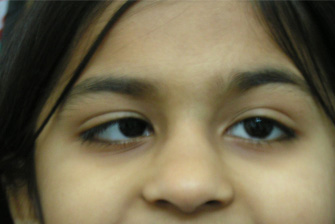CHILDHOOD EYE DISORDERS
 The wonders of the world are first encountered through the eyes of a child. Yet without good vision, a child's ability to learn about the world becomes more difficult. Vision problems affect one in 20 preschoolers and one in four school-age children. Since many vision problems begin at an early age, it is very important that children receive proper eye care. Untreated eye problems can worsen and lead to other serious problems as well as affect learning ability, personality and adjustment in school. A child's eye attains complete maturation by the age of 8 – 10 years. Hence all childhood disorders should receive attention before this age to prevent permanent loss of vision.
The wonders of the world are first encountered through the eyes of a child. Yet without good vision, a child's ability to learn about the world becomes more difficult. Vision problems affect one in 20 preschoolers and one in four school-age children. Since many vision problems begin at an early age, it is very important that children receive proper eye care. Untreated eye problems can worsen and lead to other serious problems as well as affect learning ability, personality and adjustment in school. A child's eye attains complete maturation by the age of 8 – 10 years. Hence all childhood disorders should receive attention before this age to prevent permanent loss of vision.
Parents should be aware of signs, which may indicate that their child has vision problems, including:
- Wandering or crossed eyes
- A family history of childhood vision problems
- Disinterest in reading or viewing distant objects
- Squinting or turning the head in an unusual manner while watching television
- Watching television from a very close distance
- Poor handwriting; slow writing speed; difficulty with maths; not being able to put information in order:
Common childhood eye problems include:
Refractive errors: Refractive errors are eye conditions that can cause eyestrain or a decrease in vision. They are corrected by wearing glasses or contact lenses. Hyperopia (farsightedness or the inability to focus on objects at close range) can cause children to cross their eyes. Myopia (nearsightedness or the inability to see clearly at a distance] is common in older children.
Amblyopia: Amblyopia, or "lazy eye," occurs when vision develops abnormally during early childhood. It can result from a number of underlying causes (Squint, Refractive errors etc.) and is often difficult to detect by the parents since the eyes look absolutely normal from outside. Glasses or eye-strengthening patches are used for treatment, which is most effective in preventing loss of vision when initiated at a very early age. (Discussed in detail at the end)
Allergic conjunctivitis: Eye allergies are common in children. They cause redness, itching, & watering of the eyes. Avoidance of exposure to dust is the most important & difficult part of treatment. Steroid eye drops are sometimes prescribed in severe cases & should strictly be used under the guidance of your doctor.
Strabismus (Squint ) : Strabismus is a misalignment of the eyes, which causes them to point in different directions. Strabismus is a common condition among children and affects about 4% of all children in the U.S. Glasses or an eye patch are also used to treat strabismus, but surgery may be required in some cases. When to have any eye examination for children. American Academy of Ophthalmology has recommended that school age children have a complete medical eye exam by their fourth birthday, and routine eye exams approximately every two years thereafter. So please remember that your child has to have a thorough eye exam at the earliest, if he hasn't had one as yet.

